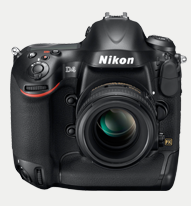In an early January 2012 PhotographyTalk.com article, the primary features of the new Nikon D4 DSLR camera were revealed, having been officially introduced January 6th. Only a few weeks had to pass before the D4 made its way into the broader digital photography community and excite semi-pros and pros with some the camera’s finer details.

Read real customer reviews of the Nikon D4 DSLR here.
- The changes to the physical shape of the D4 are what will be most evident as soon as you study pictures of the camera or are able to hold it in your hands. The primary ergonomic re-design is recognized when shooting in the portrait, or vertical, position. To the right on the back (which becomes the bottom of the camera when turned to portrait) has been added a hand-heel “well,” or indentation, to create a more secure grip of the body. An additional aid for portrait shooters is a new layout of controls, such as a multiple-access function button. More importantly, photographers will have an easier means to select AF points, with the camera turned to the portrait position, by using a joystick-type control.
Because the Nikon D4 has been created for the professional market, primarily, small functional changes, in size, are big benefits for the pro. Such a minor/big modification is a shutter button at a 35-degree angle instead of the previous 28-degree, which should cause less strain on the shutter finger during a long shooting day.
- Nikon also gave the D4 a new auto-focus sensor. Although the biggest “wow” is its capability to focus in lower light, what could be more meaningful for many pros is that the AF performs equally well with lenses with slower apertures and lenses paired with teleconverters that further reduces aperture speeds. Now, a lens with a maximum aperture of f/8 receives the assistance of the central AF point as a cross-type point.
- Pros will also cheer when they see how Nikon has upgraded the D4 DSLR’s auto ISO function. Now, it is capable of recognizing a lens’ focal length, so photographers are able to select a minimum shutter speed that correlates with the focal length. In addition, a D4 user has the flexibility to use a five-step method to skewer auto ISO for slower shutter speeds and lower ISO settings, or faster shutter speeds and higher ISO settings.
- Why would you want to shoot with a DSLR capable of capturing acceptable images in extremely low light without being able to see the camera controls? Nikon asked that very question and provided the answer by illuminating all the buttons surrounding the screen as well as those on the top left of the D4 body.
- For years, many professionals preferred high-end DSLRs without video capabilities. They were viewed as unnecessary, but shooting video has grown in importance, as many professionals have become multi-media creators, not just still photographers. The broadcast and movie industries have led the way in expanding the professional’s use of video on a DSLR. Nikon wasn’t about to lose some of that market to the Canon 5D Mark II, so Nikon gave the D4 more video features. The competitive function it has introduced is the exporting of uncompressed video via the D4’s HDMI port.
- Nikon has also moved memory card technology forward by making the D4 the first camera to include a XQD card slot. The primary benefit of the new XQD card is a faster speed, approximately 125MB/sec.
- As mentioned in the earlier PhotograpyTalk.com article about the D4, Nikon has built it with its EXPEED 3 image processor. With that additional power, the D4 now has a time-lapse movie function and in-camera HDR processing that allows the photographer to choose the number of frames applied and how the additional data is combined.
- The D4’s bigger LCD display, 3.2-inches and 921,000 dots, is an obvious pro-level improvement; but there are also a few smaller upgrades that will make pro shooters happy. These include a sensor that reads and then modifies screen brightness, saturation, contrast and gamma.
- The WT-5 Wireless Transmitter is also a nifty addition. It has a built-in, browser-based remote camera control that operates without the need for a specific app. Access a camera control dashboard with live view via a laptop, tablet or smartphone (password-secured). From there, you’re able to select most of the camera’s settings and release the shutter or start recording video.
- B&H Photo Video’s Web site states that the new Nikon D4 DSLR camera will be available for purchase on February 16, 2012, for $5,999.95 (body only) at http://www.bhphotovideo.com/c/product/838794-REG/Nikon_25482_D4_Digital_SLR_Camera.html
People who read this PhotographyTalk.com article also liked:
Feel free to visit our Nikon Camera Forum
Your feedback is important to thousands of PhotographyTalk.com fans and us. If this article is helpful, then please click the Like and Re-Tweet buttons at the top left of this article.
This post about Nikon D4 DSLR camera was first published on our website here https://www.photographytalk.com/photography-equipment-reviews/2079-10-drillin-deeper-details-of-the-new-nikon-d4-dslr-camera
This post about Nikon D4 DSLR camera was first published on our website here https://www.photographytalk.com/photography-equipment-reviews/2079-10-drillin-deeper-details-of-the-new-nikon-d4-dslr-camera